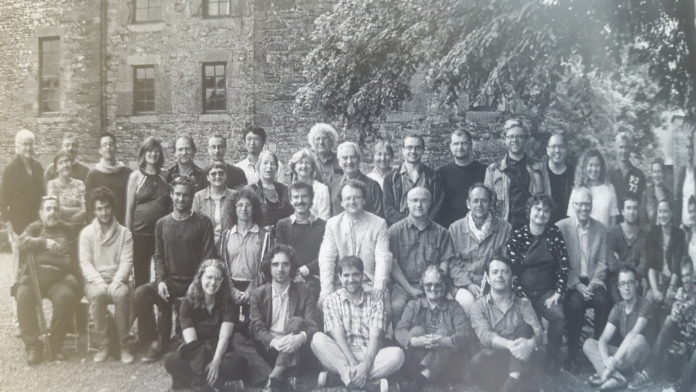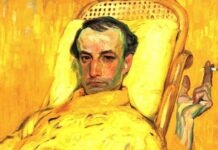
The editors of boundary 2 and b2o mourn the passing of the French philosopher Bernard Stiegler. In 2017, boundary 2 published a special issue titled “Bernard Stiegler: Amateur Philosophy,” which included three lectures on aesthetics that Stiegler delivered in Los Angeles in 2011 as well as reflections on those lectures by some of Stiegler’s closest collaborators. Duke University Press has now made those lectures freely accessible, and interested readers can access them here.
- Bernard Stiegler, “The Proletarianization of Sensibility“
- Bernard Stiegler, “Kant, Art, and Time“
- Bernard Stiegler, “The Quarrel of the Amateurs“
Also in 2017, and in relation to this special issue, b2o: An Online Journal published a text by Yuk Hui and Pieter Lemmens titled “Apocalypse, Now! Peter Sloterdijk and Bernard Stiegler on the Anthropocene.” This text is freely available through our website.
Below is a reflection that Arne De Boever wrote for Parrhesia: A Journal of Critical Philosophy about his relationship with Bernard Stiegler. It introduces a special issue of Parrhesia that collects all of the journal’s publications by Stiegler and about Stiegler’s work, and also contextualizes the boundary 2 special issue as part of a longer intellectual and personal history.
Remembering Bernard Stiegler
By Arne De Boever
I met Bernard Stiegler for the first time during the 2007-2008 academic year, when I was finishing the research for the final chapter of my doctoral dissertation in Paris, as a visiting student in Samuel Weber’s Paris Program in Critical Theory. Sam and Bernard were looking to assemble a team to translate Simondon’s L’Individuation psychique et collective (IPC), and I joined a small group of other students to take up this task. Very soon, we were meeting regularly at Stiegler’s office, high up in a building in front of the Centre Pompidou, to talk Simondon and discuss what each of us had been translating. Bernard Stiegler and Jean-Hugues Barthélémy were our advisors, and both were very generous with their time. Stiegler’s research team had created a dispositif that made our collective work easier: it showed, on the left-hand side of the computer screen, Simondon’s original French, and, on the right-hand side, our translation. It was ideal for both comparison (when we were working individually) and simultaneous review (during our group meetings). The goal of our group work was to achieve consistency of style and technical vocabulary throughout.
While this project was finished about a year later, it would (for various reasons I won’t go into here) sit on the shelf for many more years, until the University of Minnesota Press finally handed it off to Taylor Adkins, who completed the project and turned the translation into his own (it’s now finally out with Minnesota). I stayed in touch with Bernard after the experience, and obtained permission to include Kristina Lebedeva’s translation of one of his texts on Simondon and Heidegger for a special issue that Parrhesia published—the first English-language journal issue on Simondon—in 2009. In an email that he sent me as part of this correspondence, Bernard pointed out that he would in fact have preferred to see his introduction to IPC featured in the special issue, but at the time it was impossible to obtain the translation rights—so we had to put this off. Parrhesia did publish a translation of this text–“The Uncanniness of Thought and the Metaphysics of Penelope”–in 2015, and Bernard was pleased to see it out.
There was a lot to follow after Parrhesia’s special issue on Simondon: in 2010, I participated in the “Arbeitsenergien” seminar taught by Erich Hörl and Bernard Stiegler as part of the Prometheus-akademie in Essen (Germany). That’s where I met Yuk Hui, among others. In 2011, I invited Bernard to Los Angeles to deliver three lectures on aesthetics, one at the California Institute of the Arts, one at the University of California, Los Angeles (in collaboration with Kenneth Reinhard), and one at the University of California, Irvine (in collaboration with one of Bernard’s translators, Stephen Barker). These lectures were published in 2017, in a special issue of boundary 2 titled “Bernard Stiegler: Amateur Philosophy.” The issue included contributions from many of the scholars that Bernard had begun to assemble around him, partly through the organization Ars Industrialis and the school of philosophy that he and Ars Industrialis started at the watermill in Épineuil-le-Fleuriel. Several of the thinkers included in that volume—Gerald Moore, Alexander Galloway, Claire Colebrook—have also published work in Parrhesia. During the year, Bernard’s school lived online, but in Summer, its students met to continue their conversations at Bernard’s house. This is where I saw Yuk again, and met Gerald, Geert Lovink, Nandita Biswas-Mellamphy and Dan Mellamphy, among others.
The first time I presented my work in the Summer school, Jean-Hugues Barthélémy slipped me a text by Simondon on techno-aesthetics. It was a bad copy of a type-written manuscript, but the text immediately grabbed my attention, and I wanted to photocopy it so that I could maybe translate it after I had returned to the United States. Bernard thought it was a good idea, but noted there was only one copy-machine in a neighboring town: at the local bar, next to the train station–and he added that we could borrow his wife Caroline’s car to get there. With a friend, who could barely drive stick, I somehow made it to the bar, where the copy-machine in question turned out to be a fax-machine that took an eternity to reproduce a single page. Many beers later, we finally had our copy of Simondon’s multi-page manuscript, and we made it back to the watermill just in time for dinner. Parrhesia published this translation in 2012. Frédéric Neyrat’s interview with Stiegler, initially published in the journal Multitudes, came out in Parrhesia in the same year.
After his 2011 visit, Stiegler very generously returned to Los Angeles several times, once in 2013 to give a lecture on Abbas Kiarostami’s Close Up (published in Parrhesia in 2014) at the West Hollywood public library, and then in 2016 to give a closed seminar at CalArts about the neganthropocene. In 2013, I met him at the décade on Simondon at Cerisy-la-Salle, where we both spoke. I gave an account of my involvement in the project of translating Simondon into English, and focused on Simondon’s use of the term “translation” (“traduction”) in his work and tried to think the connections between translation and individuation (see Gilbert Simondon, ou l’invention du futur, which includes a long contribution by Bernard that reveals his obsession with the figure of the spiral). Responding to my account of the delay we had faced in getting our translations published, and also criticizing a professional translator in the audience who thought I should have translated Simondon less literally, more idiomatically (but at the cost of losing specific terminology in Simondon’s text), Bernard stood up in the Q&A and spoke with admiration of the translation work we had accomplished since we’d started in his office at Beaubourg, and he remarked that the delay of the translations’ publications was, and I recall exactly how he put it, “a catastrophe of transindividuation”—a catastrophe of the transindividuation that Simondon’s book, in translation, would accomplish.
In 2016, he called me very late at night after he had arrived in Los Angeles, apologizing profusely for the delay—he had been detained at Los Angeles International Airport for over four hours, and I’d left several messages. He told me he was very tired, but mostly he was angry at how he’d seen people treated—it was inhuman, he said. When I met him the day after, he was still troubled by what he’d seen. His detention had no doubt been due to his criminal record, something about which I’d never asked him, even if I continue to find the pages where he writes about his time in prison some of the most moving and philosophically powerful in his work—in Acting Out, for example, but especially in The Age of Disruption. I was under the impression that he appreciated this reticence; I’d seen him deal with questions about that time rather quickly, and dismissively, in the Question and Answer sessions after his talks. But one evening, after a family dinner at his house in Épineuil-le-Fleuriel—I am uncertain about the date–, he brought it up himself over a glass of wine on the terrace. We’d been talking about our children, my grandfather’s (and now my father’s) carpentry tools, Peter Sloterdijk, my mother’s work as a primary school teacher, and a possible visit to Los Angeles, but also about how he had taken up the habit of writing while biking, dictating his texts into a recording device while cruising the countryside roads around his house. I mentioned how much of my writing started while I was swimming (something he too, as I recall, loved to do)—how, once you have the technique down, activities like swimming or biking, especially when you do them for a long time, can push the mind to different places, so much so that often one forgets what one is doing altogether. It was then that he mentioned that when he was in jail, he used to run. “They’d let us out for physical activity,” he said, “and during that time, I ran.” And when he was running, especially after running for a while, thought started, and his mind went to a different place altogether—a place outside of prison—to such an extent that he forgot that he was running. One day, he ran for so long, he said, that he tore a muscle in his calf and collapsed in the prison courtyard, and had to be taken to a doctor afterwards.
I didn’t know what to make of the story—was he telling me not to swim for too long? Not to forget, while I was thinking, that I was swimming? Was he telling me that thinking/swimming could distract from the care of the self, even though I associated them with the care of the self? Was he saying that philosophy could make one forget about reality? Was that a good thing, or was he warning me about that? Was all of this part of thinking’s pharmakon? Thinking over the story in silence, I I was reminded of the image he’d chosen for his school of philosophy: a flying fish. A fish taking flight. A creature to add to philosophy’s bestiary.
I remembered this story when I heard about his passing, and I remembered our shared realization that intense, prolonged physical activity was able to open up a space of thought that was capable of taking us somewhere else, a place so far away that we didn’t even notice our bodies were hurt.
The last text by Stiegler that Parrhesia published was his first philosophical text, a long article titled “Technologies of Memory and Imagination” that Bernard wanted to be carefully contextualized “as an early, formative piece.” It reads like a sketch for the Technics and Time series, which would change the path of philosophy’s thinking of technology for good.
Los Angeles, August 11, 2020



